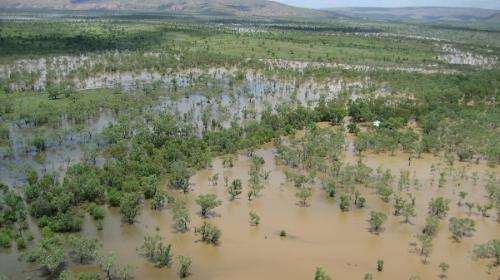Fake flooding impacts considered

Artificial flooding may be a water-efficient way to irrigate dry landscapes but scientists warn it is not a solution for all problems and the ecological impact needs more thorough monitoring.
The view that engineering solutions to water shortages using pumps, levees and weirs is a good way to alleviate water shortages to floodplain ecosystems is partly driven in Australia by the success of artificially flooding parts of the Murray Darling Basin.
The basin was artificially flooded to combat the catastrophic loss of river gums forests through prolonged drought and rising salinity.
Research co-authored by former UWA ecologist Dr Danielle Warfe warns despite that success, artificial flooding can't replicate natural flooding and it risks failing to maintain key ecosystem processes and the important connection between river and floodplain.
Dr Warfe and UWA Research Fellow Dr Neil Pettit studied the Fitzroy River in WA's north extensively, describing it as a good example of a natural river floodplain.
"Natural flooding is important for exchanging nutrients and carbon between the floodplain and the river," Dr Warfe says.
"It is especially important for allowing biota like fish, bugs and plants dispersing seeds to move between the floodplain and the river."
For example, when rivers break their banks some fish move onto the floodplain to feed on algae and insects.
The fish make considerable weight gains, using the energy to see them through the dry season when food is less plentiful.
Those exchanges don't happen if the water doesn't flow over river banks onto a floodplain.
Dr Pettit says in the Kimberley's Ord River region flooding stays within channels cut-off from the floodplain and flooding is at the wrong time of the year compared to a natural flood.
In the south-west, Mundaring Weir on the Helena River releases flows to maintain summer water pools downstream that support animal and plant life.
"A lot of those pools are drying up and so they have been releasing water to maintain some of the ecological values," Dr Pettit says.
"There needs to be careful monitoring—if you are going to release water, you need to ask how can it be released to do the best for the ecology and that means looking at when it would happen naturally and how it affects plants and animals downstream.
"Maybe you need to adjust the flow to happen at another time, more frequently, less frequently, use more water or less water.
More information: Nick Bond, Justin Costelloe, Alison King, Danielle Warfe, Paul Reich, and Stephen Balcombe 2014. "Ecological risks and opportunities from engineered artificial flooding as a means of achieving environmental flow objectives." Frontiers in Ecology and the Environment (e-View) dx.doi.org/10.1890/130259
Journal information: Frontiers in Ecology and the Environment
Provided by Science Network WA




















